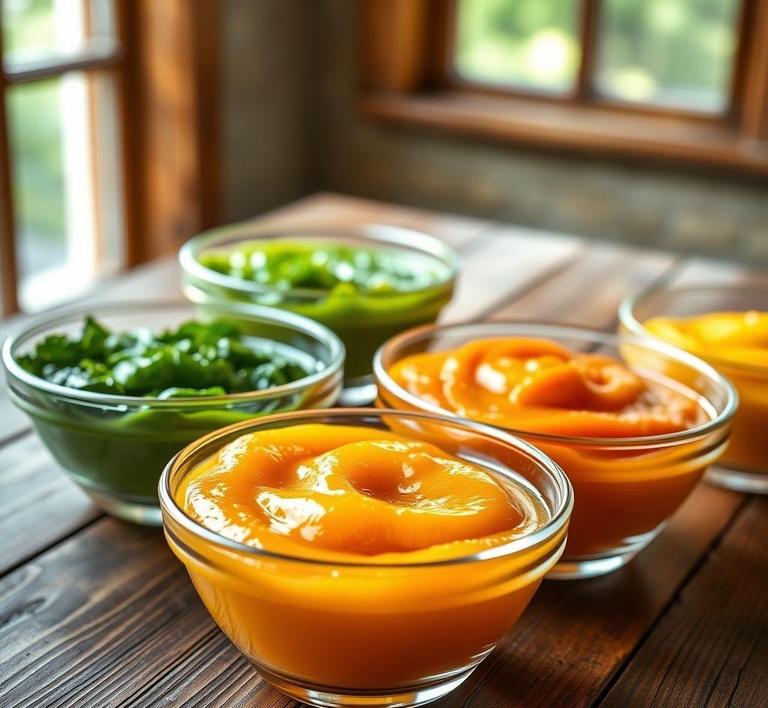Refreezing vegetable puree might sound like a no-no in the kitchen, but with the right techniques, it can be a game-changer for meal prepping and reducing food waste. Whether you’ve made too much puree or just want to store leftovers for later, knowing how to properly freeze and then refreeze vegetable purees ensures they maintain their flavor, texture, and nutrients. In this guide, we’ll walk you through the best practices for refreezing vegetable purees, from choosing the right vegetables to storing them for optimal freshness. So, if you’re looking to save time and avoid wasting that delicious homemade puree, keep reading!
Can You Refreeze Vegetable Puree?

Refreezing vegetable puree is a question that comes up frequently, especially when dealing with leftovers or when you want to extend the shelf life of a prepared batch. The answer is a bit nuanced, as it depends on a few factors. In general, yes, vegetable puree can be refrozen, but it’s important to understand the potential impact on the texture, flavor, and safety of the puree.
Vegetable purees, like those made from carrots, peas, sweet potatoes, or squash, are often made in large batches and stored for convenience. Freezing them is an excellent way to preserve their nutrients and extend their usability. However, once thawed, you might be tempted to refreeze them for later use. The concern arises mainly from the effects of freezing and thawing, which can lead to changes in texture and taste, and sometimes even safety risks if handled improperly.
To safely refreeze vegetable puree, it is crucial to follow some key principles that ensure both quality and food safety are maintained. However, refreezing any food, not just vegetable puree, should always be done with caution, especially if the puree has already been thawed and stored improperly at any stage. The key factor is understanding how much the vegetable puree has been altered during thawing and whether it’s safe to freeze again without risking spoilage.
How To Refreeze Vegetable Puree?
If you’re set on refreezing vegetable puree, it’s essential to follow specific steps to ensure it’s done correctly. Here’s a detailed guide to do so:
1. Ensure Proper Initial Freezing
- The first step is to ensure that your vegetable puree was frozen properly in the first place. This means using an airtight container or freezer-safe bags, leaving no air pockets, which helps prevent freezer burn and maintains the puree’s freshness.
- You should freeze the puree as soon as possible after preparing it. Don’t leave it sitting out at room temperature for long, as bacteria can grow rapidly in warm environments.
2. Thawing Correctly
- If you’ve already thawed the puree, make sure you do so in the safest way possible. The best way to thaw frozen vegetable puree is by transferring it to the fridge and allowing it to thaw slowly over several hours. This minimizes the risk of bacterial growth.
- Avoid thawing the puree at room temperature as this can create an environment where harmful bacteria can multiply quickly, especially in the “danger zone” temperature range of 40°F (4°C) to 140°F (60°C).
3. Check For Signs Of Spoilage
- Before refreezing, inspect the vegetable puree thoroughly. It should still smell fresh, and there should be no signs of mold or significant discoloration. If the puree has been left out too long, or if it shows signs of spoilage, it’s safer to discard it rather than risk foodborne illness.
- If the puree has been refrozen once already, it’s even more important to check it for any odd textures or smells. Purees with higher water content, like those made from tomatoes or zucchini, can separate into liquid and solid parts when thawed and refrozen, leading to unpleasant textures.
4. Portioning For Easy Use
- It’s a good idea to portion your vegetable puree into smaller servings before freezing. This not only makes it easier to defrost only the amount you need but also helps with the overall quality. Freezing in smaller batches means the puree will thaw more evenly, reducing the risk of texture degradation.
- Use freezer-safe containers or bags, and label each portion with the date it was made to keep track of how long it has been stored. This will help ensure that you don’t accidentally leave it in the freezer for too long.
5. Refreeze Quickly
- Once thawed, try to refreeze the vegetable puree as soon as possible. Don’t let it sit in the fridge for an extended period. As soon as it’s completely thawed, place it back into the freezer promptly. This reduces the chances of bacterial growth and keeps the puree as fresh as possible.
Quality Impact
While refreezing vegetable puree is technically safe if done correctly, it does come with some quality trade-offs. The main concerns are texture, flavor, and nutrient retention.
Texture Changes
- One of the biggest issues with refreezing vegetable puree is the potential change in texture. Freezing and thawing cause water in the vegetables to expand and contract. In purees that contain high water content, this can lead to separation, resulting in a watery, sometimes grainy texture upon thawing.
- For instance, purees made from water-heavy vegetables like spinach or zucchini are particularly susceptible to texture changes. The water content can separate from the solid parts of the vegetable, making the puree feel less smooth and more runny. When you refreeze it, this separation can become more pronounced.
Flavor Deterioration
- Freezing vegetable purees can mute some of their natural flavors. The more times the puree is frozen and thawed, the more the flavor can degrade. This is particularly noticeable with delicate flavors, like those found in peas, spinach, or green beans. Refreezing might make the vegetable puree taste a bit blander or duller than fresh.
Nutrient Loss
- Freezing, in general, can lead to some nutrient loss, particularly vitamins like Vitamin C, which is sensitive to temperature and storage conditions. However, the damage from refreezing is usually minimal as long as you follow proper storage guidelines. The main issue with nutrients arises more from the extended exposure to air and the freezing process itself rather than the refreezing step.
Refreezing vegetable puree is definitely possible, but it’s not without potential drawbacks. To ensure that your vegetable puree maintains its safety and quality, it’s essential to follow proper freezing and thawing techniques. Freezing it right from the start, thawing it correctly, checking for spoilage, and refreezing it promptly are all crucial steps.
While refreezing will not necessarily pose a food safety risk if done properly, you may experience some loss in texture, flavor, and nutrient content. For the best results, consider using vegetable purees within one thaw and refreeze cycle, and make sure to consume them within a reasonable period to maintain their best qualities. If texture and flavor are paramount, try to avoid refreezing if possible, as the cumulative effects of freezing can degrade the puree over time.
Ultimately, while it’s convenient to refreeze leftovers, it’s best to enjoy your vegetable purees fresh and only thaw and reheat what you need. If you do decide to refreeze, proper handling is essential for both the safety and taste of your food.
Is It Safe To Refreeze Vegetable Puree?
When it comes to food safety and quality, the topic of refreezing often raises concerns, especially with delicate foods like vegetable purees. The short answer is: it depends. In general, while it is technically safe to refreeze vegetable puree after it has been thawed, doing so can affect the texture, taste, and nutritional content of the puree. The key factors that determine whether it is safe to refreeze vegetable puree include how the puree was initially thawed and how long it has been stored.
The Science Behind Refreezing
Vegetable purees are primarily made up of water, and like many other foods, they are vulnerable to cell structure damage when frozen and thawed. When frozen, the water inside the vegetable cells forms ice crystals. Upon thawing, these ice crystals melt, and the water is released. The problem occurs when the puree is refrozen; the water inside the cells refreezes, and the subsequent thawing process causes the structure to break down further. This can lead to mushy or watery textures, which may not be very appealing, especially when it comes to certain vegetables like spinach, carrots, or peas.
Moreover, if vegetable puree is left at room temperature for too long during the thawing process, bacteria can grow, potentially leading to foodborne illnesses. Therefore, it’s essential to follow the proper safety procedures to reduce the risk of contamination when refreezing any type of food.
Signs That Vegetable Puree Should Not Be Refrozen
While refreezing vegetable puree can often be safe, there are several warning signs that indicate it should not be refrozen, as doing so may lead to compromised quality or health risks.
1. Extended Time At Room Temperature
If the vegetable puree has been left out at room temperature for more than two hours (or one hour if it’s over 90°F), it’s no longer safe to refreeze. The USDA recommends that perishable foods should not be left out for extended periods due to the rapid growth of harmful bacteria, like Salmonella and E. coli. In such cases, it’s better to discard the puree than risk consuming unsafe food.
2. Changes In Color Or Texture
When the texture of a vegetable puree becomes watery, slimy, or overly mushy after thawing, it could indicate that the vegetable cells have been damaged beyond repair. This can happen due to the breakdown of cellular structure, resulting in a puree that has lost its original flavor and appeal. Also, if you notice any color changes or an off-putting smell, these are signs that the vegetable puree has spoiled and should not be refrozen.
3. Visible Signs Of Ice Crystals Or Frost
If the vegetable puree has a large accumulation of ice crystals or a significant amount of frost within the container, it could indicate that the puree has undergone several freeze-thaw cycles. Each time a puree undergoes freezing and thawing, it loses quality. The more cycles it goes through, the greater the likelihood of bacterial growth and texture degradation, making refreezing an unwise option.
4. Fermentation Or Unpleasant Odor
Fermentation can occur if vegetable puree has been stored improperly or for too long. The presence of an unpleasant, sour, or rancid smell is a definite sign that the puree has started to spoil. This spoilage is often accompanied by bubbling or frothing, which indicates the growth of bacteria or yeast. Puree showing such signs should be discarded immediately.
Common Refreezing Mistakes
When attempting to refreeze vegetable puree, there are several common mistakes that home cooks may make that can result in a reduction of quality or even make the food unsafe to eat.
1. Thawing At Room Temperature
Thawing vegetable puree at room temperature is one of the most common mistakes when it comes to refreezing. As mentioned earlier, leaving the puree at room temperature for too long can encourage bacteria to grow, increasing the risk of foodborne illness. It is always best to thaw vegetable puree in the refrigerator, or, if in a rush, to use the microwave in short intervals. This ensures the puree remains at a safe temperature while thawing.
2. Repeated Freezing And Thawing
One of the easiest ways to degrade the texture and nutritional value of vegetable puree is by repeatedly freezing and thawing it. With each freeze-thaw cycle, the water content in the puree expands and contracts, causing the vegetable fibers to break down further. This can result in a mushy and watery puree that loses much of its original flavor. The best practice is to avoid refreezing a puree more than once.
3. Not Using Airtight Containers
When freezing vegetable puree, it is crucial to store it in airtight containers or freezer bags. Exposure to air can cause freezer burn, which not only affects the taste and texture of the food but can also lead to nutrient loss. A tightly sealed container helps preserve the flavor and nutritional integrity of the puree.
4. Not Portioning Before Freezing
Freezing large batches of vegetable puree can lead to problems when it comes time to thaw and refreeze. It’s better to divide the puree into smaller portions before freezing, so you only thaw what you need. If you thaw an entire batch and don’t use it all, you may be tempted to refreeze it, which increases the likelihood of quality deterioration. Portioning eliminates the need for this.
Tips And Tricks For Refreezing Vegetable Puree
To make sure that your vegetable puree retains its quality when refrozen, follow these tips and tricks:
1. Freeze Fresh And Blended Puree
The best time to freeze vegetable puree is when it is freshly made. The closer to the moment of preparation you freeze the puree, the more intact the texture and nutrients will remain. Avoid freezing purees that have been left in the fridge for extended periods.
2. Cool Before Freezing
Let your vegetable puree cool down completely before freezing. If you freeze it while it’s still warm, it can lead to condensation inside the container, which can lead to freezer burn or degradation in flavor. A quick cooling process will help the puree freeze evenly and retain its structure.
3. Label And Date Containers
When freezing vegetable purees, always label the containers with the type of vegetable and the date of freezing. This helps you keep track of how long the puree has been in the freezer and ensures you use it within a reasonable timeframe.
4. Use Ice Cube Trays For Portioning
To prevent thawing an entire batch at once, use ice cube trays to portion your vegetable puree. Once frozen, transfer the puree cubes into a freezer bag for easy access. This way, you can thaw only the amount you need, avoiding refreezing an entire portion.
5. Consider Adding A Stabilizer
For purees that tend to separate or become watery after thawing, consider adding a stabilizing ingredient like cornstarch or arrowroot powder before freezing. This can help maintain the consistency of the puree once it’s been thawed and refrozen.
Conclusion
Refreezing vegetable puree can be done safely, but it requires careful attention to the freezing and thawing process to avoid compromising the quality and safety of the food. By following proper procedures-such as avoiding thawing at room temperature, using airtight containers, and limiting the number of freeze-thaw cycles-you can preserve the integrity of your vegetable purees. Keep an eye out for signs of spoilage or quality degradation, and always remember to handle your purees with care. If done correctly, refreezing can be a convenient way to extend the shelf life of your vegetable purees while ensuring that they remain safe and nutritious.


